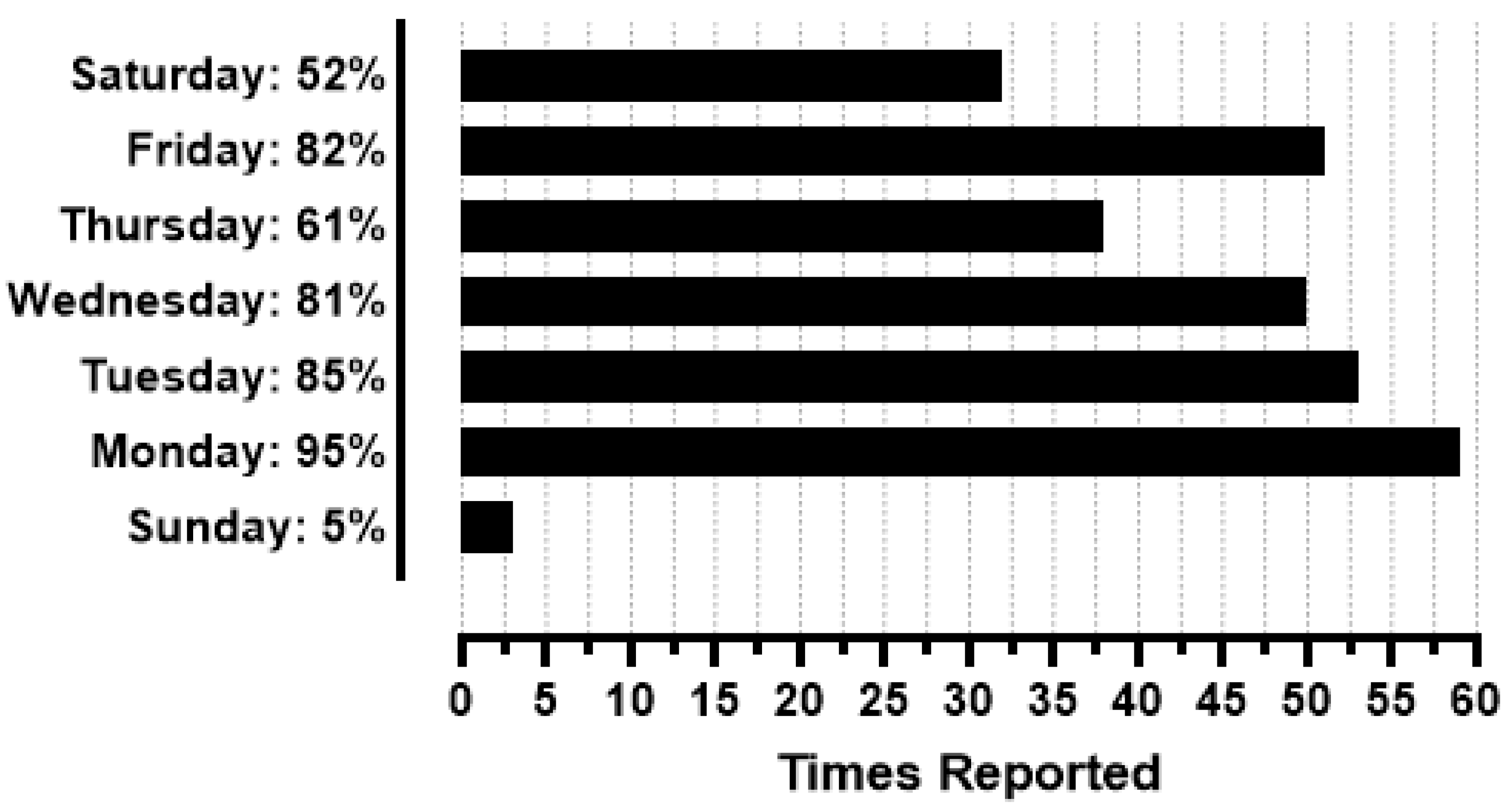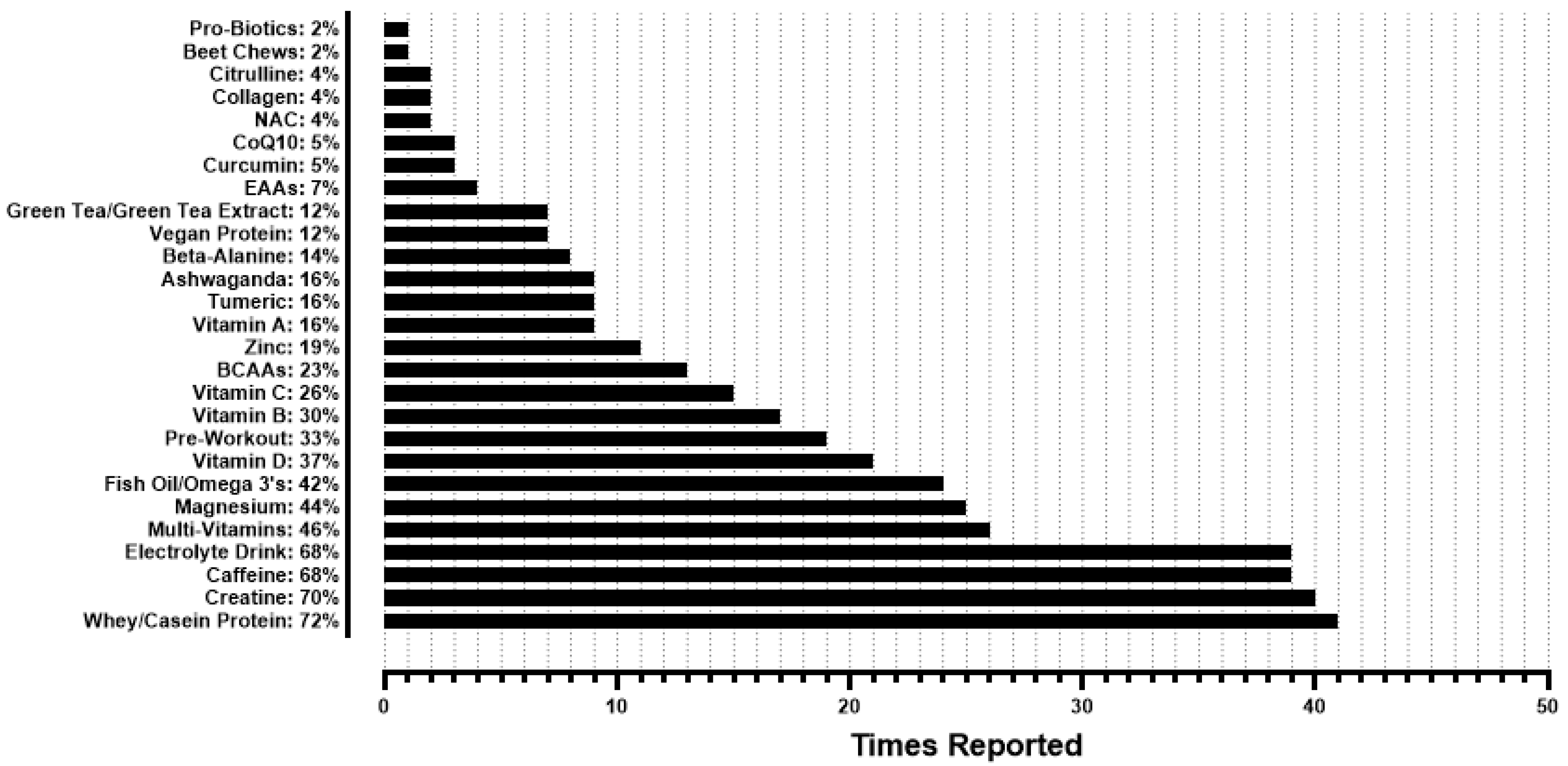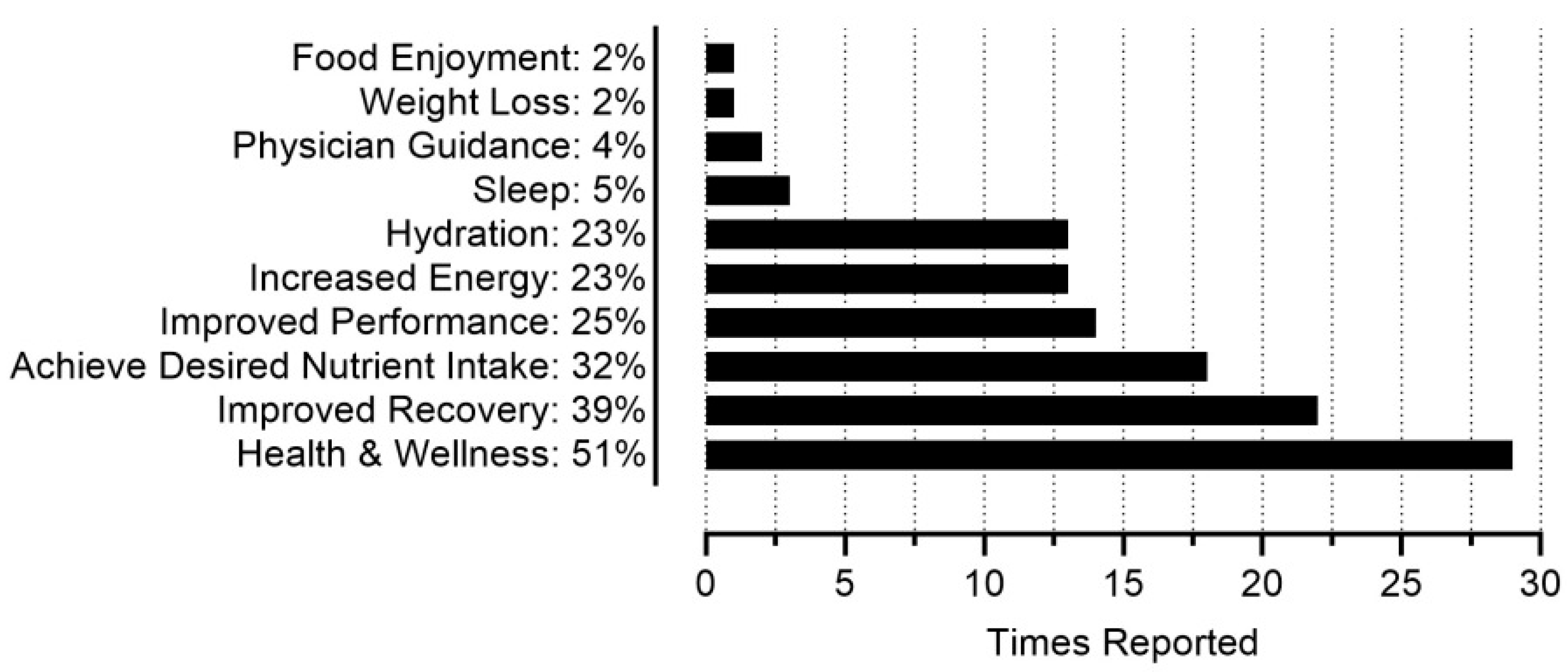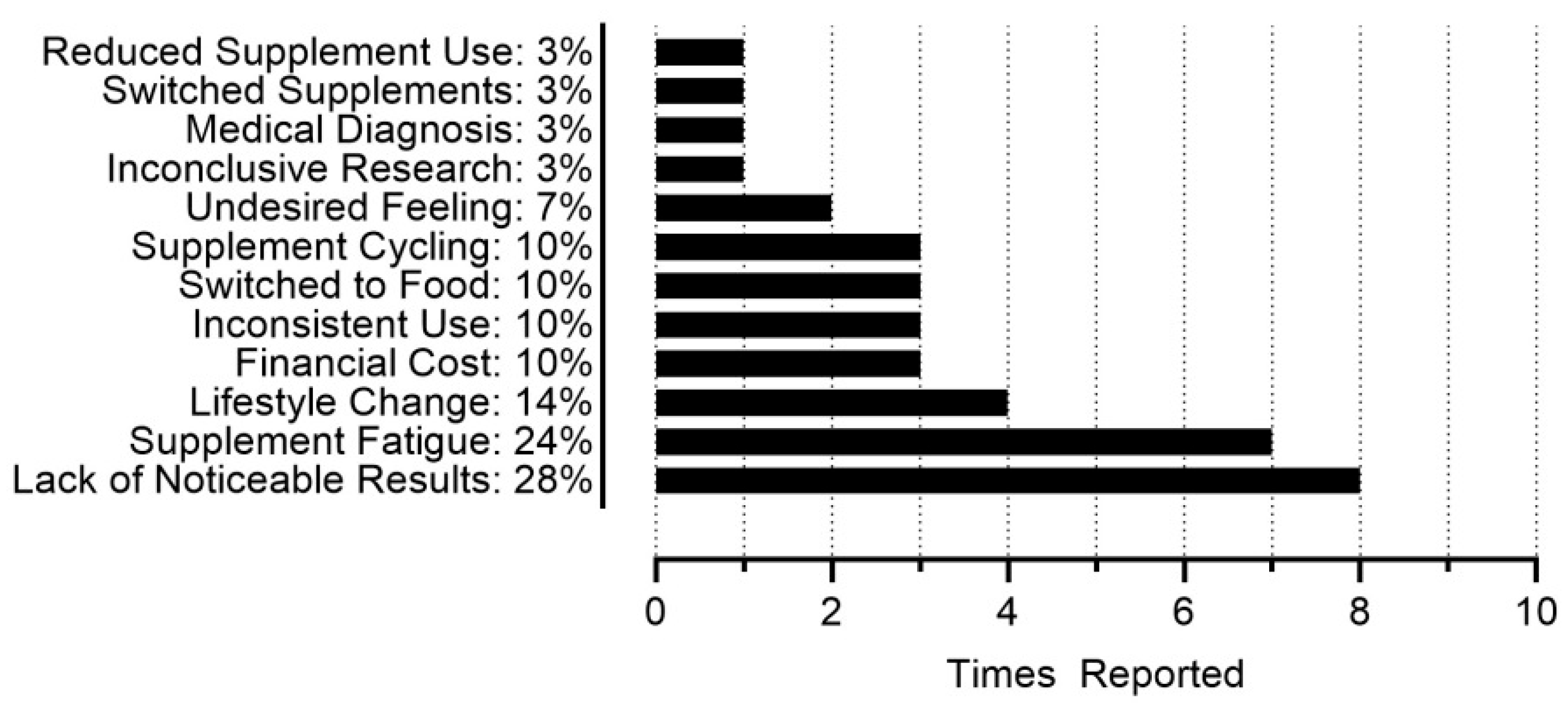Describing Dietary Habits and Body Composition Among High-Intensity Functional Training Athletes: A Mixed Methods Approach
Abstract
1. Introduction
2. Materials and Methods
2.1. Study Design
2.2. Rapid Eating Assessment for Participants
2.3. Bioelectrical Impedance Analysis
2.4. Air Displacement Plethysmography
2.5. Questionnaires
2.6. Statistical Analysis
3. Results
3.1. Demographics and HIFT Participation
3.2. Body Composition
3.3. Dietary Habits
4. Discussion
5. Conclusions
Author Contributions
Funding
Institutional Review Board Statement
Informed Consent Statement
Data Availability Statement
Acknowledgments
Conflicts of Interest
Abbreviations
| BMI | Body Mass Index |
| HIFT | High-Intensity Functional Training |
| SNK | Sports Nutrition Knowledge |
Appendix A
| All (N = 62) | Male (n = 36) | Female (n = 26) | |
|---|---|---|---|
| Body Mass (kg) | 76.9 ± 15.5 (44.4–113.0) | 86.3 ± 11.1 (65.9–113.0) | 63.8 ± 10.1 (44.4–94.3) |
| Body Fat Percentage (%) | 20.8 ± 7.1 (6.0–39.8) | 18.1 ± 5.6 (6.0–28.5) | 24.4 ± 7.3 (11.0–39.8) |
| Fat Mass (kg) | 15.9 ± 6.1 (4.5–29.8) | 15.9 ± 6.0 (4.5–29.8) | 15.9 ± 6.4 (4.9–29.7) |
| Fat-Free Mass (kg) | 61.0 ± 13.6 (37.3–92.9) | 70.4 ± 8.4 (55.5–92.9) | 47.9 ± 6.6 (37.3–65.0) |
| Impedance (Ω) | 544.0 ± 80.6 (387.0–764.0) | 494.0 ± 52.8 (387.0–607.0) | 611.0 ± 60.0 (510.0–764.0) |
| Resistance (Ω) | 540.0 ± 80.5 (383.0–761.0) | 490.0 ± 52.6 (383.0–603.0) | 608.0 ± 59.9 (507.0–761) |
| Reactance (Ω) | 61.6 ± 7.5 (41.8–76.0) | 59.5 ± 6.8 (41.8–72.5) | 64.4 ± 7.6 (46.7–76.0) |
| Impedance Ratio | 0.768 ± 0.025 (0.716–0.840) | 0.755 ± 0.019 (0.716–0.797) | 0.785 ± 0.021 (0.753–0.840) |
| Phase Angle (°) | 6.58 ± 0.75 (4.50–8.20) | 6.94 ± 0.60 (5.60–8.20) | 6.08 ± 0.64 (4.50–7.00) |
References
- What is CrossFit? Available online: https://www.crossfit.com/what-is-crossfit (accessed on 6 July 2025).
- Mangine, G.T.; Stratton, M.T.; Almeda, C.G.; Roberts, M.D.; Esmat, T.A.; VanDusseldorp, T.A.; Feito, Y. Physiological differences between advanced CrossFit athletes, recreational CrossFit participants, and physically-active adults. PLoS ONE 2020, 15, e0223548. [Google Scholar] [CrossRef]
- HYROX: The History. Available online: https://hyrox.com/the-history/ (accessed on 17 September 2025).
- F45: International Franchise Expo. Available online: https://f45training.com/ife/ (accessed on 17 September 2025).
- DEKA. Available online: https://www.spartan.com/en/deka (accessed on 17 September 2025).
- de Souza, R.A.S.; da Silva, A.G.; de Souza, M.F.; Souza, L.K.F.; Roschel, H.; da Silva, S.F.; Saunders, B. A Systematic Review of CrossFit(R) Workouts and Dietary and Supplementation Interventions to Guide Nutritional Strategies and Future Research in CrossFit(R). Int. J. Sport. Nutr. Exerc. Metab. 2021, 31, 187–205. [Google Scholar] [CrossRef]
- Knapik, J.J.; Steelman, R.A.; Hoedebecke, S.S.; Austin, K.G.; Farina, E.K.; Lieberman, H.R. Prevalence of Dietary Supplement Use by Athletes: Systematic Review and Meta-Analysis. Sports Med. 2016, 46, 103–123. [Google Scholar] [CrossRef] [PubMed]
- Brisebois, M.; Kramer, S.; Lindsay, K.G.; Wu, C.-T.; Kamla, J. Dietary practices and supplement use among CrossFit® participants. J. Int. Soc. Sports Nutr. 2022, 19, 316–335. [Google Scholar] [CrossRef] [PubMed]
- Gogojewicz, A.; Śliwicka, E.; Durkalec-Michalski, K. Assessment of dietary intake and nutritional status in CrossFit-trained individuals: A descriptive study. Int. J. Environ. Res. Public Health 2020, 17, 4772. [Google Scholar] [CrossRef]
- Pearson, R.C.; Jenkins, N.T. Dietary Intake of Adults Who Participate in CrossFit® Exercise Regimens. Sports 2022, 10, 38. [Google Scholar] [CrossRef]
- Menargues-Ramírez, R.; Sospedra, I.; Holway, F.; Hurtado-Sánchez, J.A.; Martínez-Sanz, J.M. Evaluation of body composition in CrossFit® athletes and the relation with their results in official training. Int. J. Environ. Res. Public Health 2022, 19, 11003. [Google Scholar] [CrossRef] [PubMed]
- de Sousa, A.F.; dos Santos, G.B.; dos Reis, T.; Valerino, A.J.; Del Rosso, S.; Boullosa, D.A. Differences in Physical Fitness between Recreational CrossFit® and Resistance Trained Individuals. J. Exerc. Physiol. Online 2016, 19, 112–122. [Google Scholar]
- Cebrián-Ponce, Á.; Serafini, S.; Petri, C.; Carrasco-Marginet, M.; Izzicupo, P.; Mascherini, G. Somatotype and bioelectrical impedance vector analysis of Italian CrossFit® practitioners. Heliyon 2024, 10, e29139. [Google Scholar] [CrossRef]
- Lafontant, K. Created in BioRender. Flow of Study Procedures. 2025. Available online: https://BioRender.com/uuhihve (accessed on 22 September 2025).
- Segal-Isaacson, C.; Wylie-Rosett, J.; Gans, K.M. Validation of a short dietary assessment questionnaire: The Rapid Eating and Activity Assessment for Participants short version (REAP-S). Diabetes Educ. 2004, 30, 774–781. [Google Scholar] [CrossRef]
- Lukaski, H.C.; Kyle, U.G.; Kondrup, J. Assessment of adult malnutrition and prognosis with bioelectrical impedance analysis: Phase angle and impedance ratio. Curr. Opin. Clin. Nutr. Metab. Care 2017, 20, 330–339. [Google Scholar] [CrossRef] [PubMed]
- Lukaski, H.C.; Garcia-Almeida, J.M. Phase angle in applications of bioimpedance in health and disease. Rev. Endocr. Metab. Disord. 2023, 24, 367–370. [Google Scholar] [CrossRef]
- Siri, W.; Brozek, J.; Henschel, A. Techniques for Measuring Body Composition; National Academy of Sciences: Washington, DC, USA, 1961; pp. 223–224. [Google Scholar]
- Love, J.; Droppmann, D.; Selker, R.; Gallucci, M.; Jentschke, S.; Balci, S.; Seol, H.; Agosti, M. Jamovi®, version 2.5.6; The Jamovi Project: Sydney, Australia, 2024.
- Maxwell, C.; Ruth, K.; Friesen, C. Sports Nutrition Knowledge, Perceptions, Resources, and Advice Given by Certified CrossFit Trainers. Sports 2017, 5, 21. [Google Scholar] [CrossRef]
- Singh, A.; Singh, D. The Paleolithic Diet. Cureus 2023, 15, e34214. [Google Scholar] [CrossRef]
- King, D.E.; Mainous, A.G., 3rd; Carnemolla, M.; Everett, C.J. Adherence to healthy lifestyle habits in US adults, 1988–2006. Am. J. Med. 2009, 122, 528–534. [Google Scholar] [CrossRef]
- Martinho, D.V.; Rebelo, A.; Clemente, F.M.; Costa, R.; Gouveia, E.R.; Field, A.; Casonatto, J.; van den Hoek, D.; Durkalec-Michalsk, K.; Ormsbee, M.J.; et al. Nutrition in CrossFit(R)-scientific evidence and practical perspectives: A systematic scoping review. J. Int. Soc. Sports Nutr. 2025, 22, 2509674. [Google Scholar] [CrossRef]
- Freitas, J.C.R.d.S.O. Potencial Ergogénico e Uso da Creatinina e da Beta-Alanina no Contexto do CrossFit e da Musculação. 2016. Available online: https://core.ac.uk/download/pdf/148829073.pdf (accessed on 17 September 2025).
- de Lima Lins, T.C.; de Souza, L.P.V. Dieta pré e pós treino em praticantes de crossfit®: Um perfil qualitativo do consumo de alimentos e suplementos. RBNE-Rev. Bras. Nutr. Esportiva 2019, 13, 946–953. [Google Scholar]
- Fayad, D. A Influência da Estratégia Nutricional no Rendimento de Atletas Competitivos de Crossfit. 2019. Available online: https://repositorio.uniceub.br/jspui/handle/prefix/13504 (accessed on 17 September 2025).
- Brescansin, B.M.; Naziazeno, R.F.T.; de Miranda, T.V. Análise do perfil alimentar de praticantes de CrossFit na região de Belém do Pará. RBNE-Rev. Bras. Nutr. Esportiva 2019, 13, 830–838. [Google Scholar]
- Rebouças Filho, M.; Mendonça, L.P. Perfil alimentar e utilização de suplementos nutricionais de praticantes de cross training do Box Crossfit Sertão no município de Mossoró. RBNE-Rev. Bras. Nutr. Esportiva 2022, 16, 466–474. [Google Scholar]
- Comerlatto, V.; Zanella, P.B.; Hoefel, A.L. Crossfit® practitioners profile with regard to the prevalence of use of dietary supplements and anabolic androgenic steroids as ergogenic resources. RBNE-Rev. Bras. Nutr. Esportiva 2023, 17, 575–584. [Google Scholar]
- Higino, D.D.; Freitas, R.F. Prevalência e fatores associados ao uso de suplementos alimentares e esteroides anabólicos androgênicos em praticantes de CrossFIT. RBNE-Rev. Bras. Nutr. Esportiva 2021, 15, 9–23. [Google Scholar]
- Jager, R.; Kerksick, C.M.; Campbell, B.I.; Cribb, P.J.; Wells, S.D.; Skwiat, T.M.; Purpura, M.; Ziegenfuss, T.N.; Ferrando, A.A.; Arent, S.M.; et al. International Society of Sports Nutrition Position Stand: Protein and exercise. J. Int. Soc. Sports Nutr. 2017, 14, 20. [Google Scholar] [CrossRef] [PubMed]
- dos Santos Quaresma, M.V.; Marques, C.G.; Nakamoto, F.P. Effects of diet interventions, dietary supplements, and performance-enhancing substances on the performance of CrossFit-trained individuals: A systematic review of clinical studies. Nutrition 2021, 82, 110994. [Google Scholar] [CrossRef] [PubMed]
- Liguori, G.; American College of Sports Medicine. ACSM’s Guidelines for Exercise Testing and Prescription, 11th ed.; Lippincott Williams & Wilkins: Philadelphia, PA, USA, 2021. [Google Scholar]





| Brand | n of Global Participants |
|---|---|
| CrossFit® | 5,000,000 |
| Hyrox® | >90,000 |
| F45® | 300,000 |
| Mean ± SD or n (%) | |
|---|---|
| Age (years) | 36.3 ± 11.7 (18–64) |
| Sex | Female = 26 (41.9%) Male = 36 (58.1%) |
| Ethnicity | Hispanic = 15 (24.2%) Non-Hispanic = 47 (75.8%) |
| Race | Asian = 7 (11.3%) Black = 1 (1.6%) Hispanic/Latino = 10 (16.1%) White = 38 (61.3%) Middle Eastern = 2 (3.2%) Mixed Race = 4 (6.5%) |
| All (N = 62) | Male (n = 36) | Female (n = 26) | |
|---|---|---|---|
| Body Mass (kg) | 76.8 ± 15.5 (44.4–113.0) | 86.2 ± 11.3 (65.9–113.0) | 63.8 ± 10.1 (44.4–94.3) |
| Body Mass Index (kg/m2) | 25.8 ± 3.4 (18.2–32.7) | 27.2 ± 2.7 (22.2–32.7) | 23.9 ± 3.4 (18.2–32.2) |
| Body Fat % | 20.4 ± 6.9 (6.5–37.6) | 17.7 ± 5.6 (6.5–27.6) | 24.3 ± 6.9 (10.6–37.6) |
| Fat Mass (kg) | 15.6 ± 5.9 (5.0–29.9) | 15.5 ± 5.9 (5.0–28.7) | 15.8 ± 6.2 (5.1–29.9) |
| Fat-Free Mass (kg) | 61.2 ± 13.7 (36.8–94.8) | 70.8 ± 8.3 (55.8–94.8) | 48.0 ± 6.5 (36.8–64.4) |
| Total Body Density (kg/L) | 1.05 ± 0.02 (1.02–1.09) | 1.06 ± 0.01 (1.03–1.09) | 1.04 ± 0.02 (1.02–1.08) |
| Total Body Volume (L) | 73.0 ± 14.6 (41.5–106.0) | 81.5 ± 10.9 (61.9–106.0) | 61.1 ± 10.2 (41.5–91.9) |
| Total Body Water (L) | 44.6 ± 9.9 (27.3–68.2) | 51.6 ± 6.1 (40.7–68.2) | 35.1 ± 4.8 (27.3–47.6) |
| Usually/Often | Sometimes | Rarely/Never | |
|---|---|---|---|
| Skip breakfast? | 9 (14.5%) | 12 (19.4%) | 41 (66.1%) |
| Eat 4 or more meals from sit-down or take out restaurants? | 3 (4.8%) | 16 (25.8%) | 43 (69.4%) |
| Eat less than 2 servings of whole-grain products or high-fiber starches a day? | 12 (19.4%) | 24 (38.7%) | 26 (41.9%) |
| Eat less than 2 servings of fruit a day? | 15 (24.2%) | 25 (40.3%) | 22 (35.5%) |
| Eat less than 2 servings of vegetables a day? | 10 (16.1%) | 22 (35.5%) | 30 (48.4%) |
| Eat or drink less than 2 servings of milk, yogurt, or cheese a day? | 14 (22.6%) | 18 (29.0%) | 30 (48.4%) |
| Eat more than 8 ounces (~227 g) of meat, chicken, turkey or fish per day? | 44 (71.0%) | 15 (24.2%) | 3 (4.8%) |
| Use regular processed meats (e.g., bologna, salami, hotdogs, or bacon) instead of low-fat processed meats (like roast beef, turkey, lean ham)? | 3 (4.8%) | 15 (24.2%) | 44 (71.0%) |
| Eat fried foods? | 6 (9.7%) | 25 (40.3%) | 31 (50.0%) |
| Eat regular snack chips, popcorn, or nuts instead of pretzels, low-fat chips or low-fat crackers, air-popped popcorn? | 4 (6.5%) | 23 (37.1%) | 35 (56.4%) |
| Add butter, margarine or oil to bread, potatoes, rice or vegetables at the table? | 7 (11.3%) | 23 (37.1%) | 32 (51.6%) |
| Eat sweets like cake, cookies, pastries, or candies more than 2 times per day. | 5 (8.1%) | 23 (37.1%) | 34 (54.8%) |
| Drink 16 (~473 mL) ounces or more of non-diet soda or fruit drink/punch per day? | 1 (1.6%) | 6 (9.7%) | 55 (88.7%) |
Disclaimer/Publisher’s Note: The statements, opinions and data contained in all publications are solely those of the individual author(s) and contributor(s) and not of MDPI and/or the editor(s). MDPI and/or the editor(s) disclaim responsibility for any injury to people or property resulting from any ideas, methods, instructions or products referred to in the content. |
© 2025 by the authors. Licensee MDPI, Basel, Switzerland. This article is an open access article distributed under the terms and conditions of the Creative Commons Attribution (CC BY) license (https://creativecommons.org/licenses/by/4.0/).
Share and Cite
Lafontant, K.; Livingston, J.; Smith, S.; Da Silva Barbera, M.A.; Gonzalez, C.; Kampiyil, S.; Nguyen, N.L.N.; Johnson, B.; Stout, J.R.; Fukuda, D.H. Describing Dietary Habits and Body Composition Among High-Intensity Functional Training Athletes: A Mixed Methods Approach. Sports 2025, 13, 340. https://doi.org/10.3390/sports13100340
Lafontant K, Livingston J, Smith S, Da Silva Barbera MA, Gonzalez C, Kampiyil S, Nguyen NLN, Johnson B, Stout JR, Fukuda DH. Describing Dietary Habits and Body Composition Among High-Intensity Functional Training Athletes: A Mixed Methods Approach. Sports. 2025; 13(10):340. https://doi.org/10.3390/sports13100340
Chicago/Turabian StyleLafontant, Kworweinski, Jack Livingston, Sofea Smith, Michelle A. Da Silva Barbera, Claudia Gonzalez, Susan Kampiyil, Ngoc Linh Nhi Nguyen, Blake Johnson, Jeffrey R. Stout, and David H. Fukuda. 2025. "Describing Dietary Habits and Body Composition Among High-Intensity Functional Training Athletes: A Mixed Methods Approach" Sports 13, no. 10: 340. https://doi.org/10.3390/sports13100340
APA StyleLafontant, K., Livingston, J., Smith, S., Da Silva Barbera, M. A., Gonzalez, C., Kampiyil, S., Nguyen, N. L. N., Johnson, B., Stout, J. R., & Fukuda, D. H. (2025). Describing Dietary Habits and Body Composition Among High-Intensity Functional Training Athletes: A Mixed Methods Approach. Sports, 13(10), 340. https://doi.org/10.3390/sports13100340








